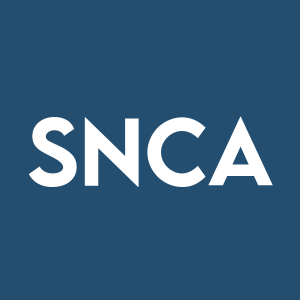Seneca Biopharma, Inc. Announces Top Line Data from Phase 2 Clinical Study in China for the Treatment of Ischemic Stroke
Seneca Biopharma (SNCA) announced preliminary results from its Phase 2 stroke study for NSI-566, a human neural stem cell therapy, conducted in Beijing, China. The trial involved 23 patients with ischemic stroke, assessing treatment safety and efficacy against placebo. Results showed a mean improvement in the Fugl-Meyer Motor Score of 12.20 points for the treatment group versus 6.30 for placebo, although not statistically significant (p=0.231). Adverse events were reported in the treatment arm, including impaired wound healing and hepatic function concerns. Further studies are essential to confirm NSI-566's potential.
- NSI-566 demonstrated mean improvement of 12.20 points in FMMS compared to 6.30 points in placebo.
- Two patients in the treatment group showed significant improvements of 32 and 44 points.
- Mean improvement in FMMS did not reach statistical significance (p=0.231).
- Three serious adverse events occurred in the treatment group, including impaired healing and hepatic function issues.
Insights
Analyzing...
GERMANTOWN, Md., Jan. 20, 2021 /PRNewswire/ -- Seneca Biopharma, Inc. (Nasdaq: SNCA), a biopharmaceutical company focused on developing novel treatments for diseases of high unmet medical need, today announced preliminary, top-line results of the Company's placebo controlled Phase 2 stroke study (non-GCP) that was conducted in Beijing, China. The trial was designed to evaluate the relative safety of the Company's human neural stem cell therapy, NSI-566, in patients with stable deficits in motor function resulting from ischemic stroke. Patients were eligible for the trial if they had documented history of ischemic stroke at least four months, but no more than 24 months, before surgery.
The study enrolled 23 patients who were randomly assigned to treatment or placebo arms. Patients in the treatment arm received intracerebral injection of 72 million stem cells, whereas those in the placebo group underwent a sham surgery procedure. Secondary objectives to evaluate efficacy were performed by qualified assessors who were blinded to treatment assignment, and included the Fugl-Meyer Motor Score (FMMS), an assessment of upper and lower motor function that comprises a 100 point scale and is widely used following stroke.
Patients enrolled in the treatment and placebo arms had similar baseline FMMS scores before surgery (mean ± SD: 36.80 ± 8.59 and 35.80 ± 4.66, respectively). While most participants showed some improvement in FMMS from pre-surgery scores, the mean improvement after one year was greater in those participants receiving NSI-566 (n=10, mean ± SD: 12.20 ± 14.15) compared to placebo (n=10, 6.30 ± 5.14), though the difference between groups did not reach statistical significance using the approximate Student's t-test (MMRM) (p=0.231). Two participants in the treatment arm showed clinically important improvements of 32 and 44 points on the FMMS following treatment with NSI-566, whereas the largest improvement observed in the placebo group was 17 points. Participants in the treatment arm experienced a total of three serious adverse events (SAE) that were considered by the investigator to be probably or possibly related to treatment, whereas no patients in the placebo arm experienced SAEs. Treatment-related SAEs were resolved with standard medical care and were limited to impaired healing at the incision site and wound dehiscence in one patient, and impaired hepatic function in another.
"Stroke is a leading cause of death and disability in China," said professor Ruxiang Xu, former president of BaYi Brain Hospital in Beijing, China and study principal investigator. "Results from this study show NSI-566 may have utility as a treatment for paralysis and motor deficits caused by ischemic stroke. Additional larger studies will be critical in demonstrating the clinical potential of NSI-566 in this unmet need."
About Seneca Biopharma, Inc.
Seneca Biopharma, Inc., is a clinical-stage biopharmaceutical company developing novel treatments for diseases of high unmet medical need. On December 17, 2020, Seneca announced that it had entered into a definitive Merger Agreement with Leading BioSciences, Inc. (LBS), a privately held company focused on developing novel therapeutics to improve human health through therapeutic protection of the gastrointestinal mucosal barrier. Pursuant to the Merger Agreement, Seneca is seeking to sell off its rights to NSI-566. Upon completion of the merger, the company is expected to operate under the name Palisade Bio, Inc. and trade on the Nasdaq Capital Market under the ticker symbol PALI.
About Ischemic Stroke
Ischemic stroke, the most common type of stroke, occurs as a result of an obstruction within a blood vessel supplying blood to the brain. Approximately 15 million people worldwide suffer stroke each year, of which approximately
Cautionary Statement Regarding Forward Looking Information:
This news release contains "forward-looking statements" made pursuant to the "safe harbor" provisions of the Private Securities Litigation Reform Act of 1995. Such forward-looking statements relate to future, not past, events and may often be identified by words such as "expect," "anticipate," "intend," "plan," "believe," "seek" or "will." Forward-looking statements by their nature address matters that are, to different degrees, uncertain. Specific risks and uncertainties that could cause our actual results to differ materially from those expressed in our forward-looking statements include risks inherent in the development and commercialization of potential products, uncertainty of clinical trial results or regulatory approvals or clearances, need for future capital, dependence upon collaborators and maintenance of our intellectual property rights. Actual results may differ materially from the results anticipated in these forward-looking statements. Additional information on potential factors that could affect our results and other risks and uncertainties are detailed from time to time in Seneca's periodic reports filed with the Securities and Exchange Commission (SEC), including its Annual Report on Form 10-K for the year ended December 31, 2019, its Quarterly Reports on Form 10-Q as well as and in other reports filed with the SEC. We do not assume any obligation to update any forward-looking statements.
![]() View original content:http://www.prnewswire.com/news-releases/seneca-biopharma-inc-announces-top-line-data-from-phase-2-clinical-study-in-china-for-the-treatment-of-ischemic-stroke-301211384.html
View original content:http://www.prnewswire.com/news-releases/seneca-biopharma-inc-announces-top-line-data-from-phase-2-clinical-study-in-china-for-the-treatment-of-ischemic-stroke-301211384.html
SOURCE Seneca Biopharma, Inc.







